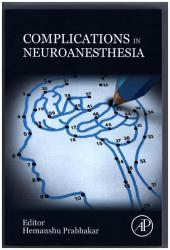 Neuerscheinungen 2016Stand: 2020-02-01 |
Schnellsuche
ISBN/Stichwort/Autor
|
Herderstraße 10
10625 Berlin
Tel.: 030 315 714 16
Fax 030 315 714 14
info@buchspektrum.de |

Hemanshu Prabhakar
Complications in Neuroanesthesia
Ed. by Hemanshu Prabhakar
2016. 500 p. 23,5 cm
Verlag/Jahr: ACADEMIC PRESS 2016
ISBN: 0-12-804075-0 (0128040750)
Neue ISBN: 978-0-12-804075-1 (9780128040751)
Preis und Lieferzeit: Bitte klicken
Complications in Neuroanesthesia focuses on complications that may arise related to neuroanesthesia practice and discusses its various causes. Each complication is written as a separate chapter, and the pathophysiology and mechanisms of each complication, as well as measures for diagnosis, treatment and prevention are discussed. Towards the end of the book, several case scenarios are provided to the readers that challenge readers to diagnose the possible complication for each case. Chapters include brain and spinal cord problems, cardiovascular and hematological problems, and nerve and muscle problems.
Written in a standard format, Complications in Neuroanesthesia provides quick and easy access to understanding problems in neuroanesthesia. It provides insight into all possible complications occurring during perioperative management of neurosurgical and neurologic patients. It is useful for trainees, clinicians, and researchers in the fields of neurosurgery, neurocritical care, and neurology by providing an understanding of preventable mishaps that may occur in neurosurgical or neurologic patients.
Quick and easy reference for understanding problems in neuroanesthesia
Provides comprehensive insights into all possible complications occurring during perioperative management of neurosurgical and neurologic patients
Includes useful section with clinical case studies of complications in neuroanesthesia
Section I. Complications Related to the Brain 1. Brain herniation 2. Delayed emergence 3. Hydrocephalus 4. Normal Perfusion Pressure Breakthrough 5. Pneumocephalus 6. Seizures 7. Brain swelling and Tense Brain Section II. Complications Related to Spinal Cord 8. Autonomic disturbances 9. Pneumorrhachis 10. Post-Operative Paraplegia and Quadriplegia 11. Spinal shock Section III. Complications Related to Cardiovascular System 12. Aneurysm / arteriovascular malformation rupture 13. Vasospasm 14. Electrocardiogram abnormalities 15. Hemodynamic instability 16. Vascular injuries Section IV. Complications related to coagulations 17. Coagulopathy 18. Postoperative hematoma 19. Thromboembolism Section V. Complications Related to Respiratory System 20. Hypercarbia 21. Hypoxia 22. Neurogenic pulmonary edema Section VI. Complications Related to Airway 23. Intraoperative increased airway pressure 24. Difficult airway - Adults 25. Difficult airway - pediatrics 26. Stridor Section VII. Complications Related to Fluid and Electrolyte Disturbances 27. Osmotic demyelination syndromes 28. Cerebral Salt Wasting 29. Diabetes Insipidus 30. Syndrome of Inappropriate Antidiuretic Hormone Secretion (SIADH) Section VIII. Postoperative Pain 31. Pain following spine surgery 32. Post-craniotomy pain Section IX. Miscellaneous 33. Anaphylaxis 34. Hazards of Advanced Neuromonitoring 35. Hypothermia 36. Nausea and vomiting 37. Peripheral nerve injuries 38. Pharmacological complications 39. Position related complications 40. Postoperative vision loss 41. Postoperative cognitive dysfunction 42. Trigeminocardiac reflex 43. Venous air embolism Section X. Clinical Scenarios 44. Clinical Scenario 1 45. Clinical Scenario 2 46. Clinical Scenario 3 47. Clinical Scenario 4 48. Clinical Scenario 5 49. Clinical Scenario 6 50. Clinical Scenario 7 51. Clinical Scenario 8 52. Clinical Scenario 9 53. Clinical Scenario 10


